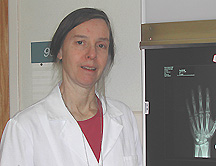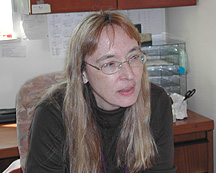

| T H E N I H C A T A L Y S T | M A R C H – A P R I L 2002 |
|
|
|
Bench-to-Bedside: McCune-Albright Syndrome
NICHD,
NIDCR RESEARCHERS CONTINUE PROBING
|
 |
|
Penelope
Feuillan
|
 |
|
Pamela
Robey
|
NIH has a long history of research on the McCune-Albright syndrome (MAS).
Penelope Feuillan, Gordon Cutler, and other NICHD researchers pioneered the treatment of the endocrinopathies in MAS patients, specifically those with precocious puberty, more than 15 years ago.
|
MAS Background The McCune-Albright syndrome (MAS, first described in 1937) is characterized by at least two of a triad of features: (1) polyostotic fibrous dysplasia (PFD) that causes focal damage to bones, (2) hyperpigmentation, and (3) autonomous endocrine hyperfunction. The endocrine disease includes early puberty with menstrual bleeding, development of breasts and pubic hair, and an increased rate of growth. Precocious puberty may start as early as infancy and is more common in girls—ovaries seem to be more susceptible to the G-protein malfunction associated with MAS. Apart from the early onset, precocious puberty differs from normal puberty in that the brain centers normally mediating puberty are often not active in MAS and there is autonomous secretion of estrogen from the ovaries. MAS is believed to be caused by genetic mutations within Gs-a occurring after the egg has been fertilized. This timing results in somatic mosaicism and varying degrees of severity depending on where the mutation is expressed. Apart from the reproductive organs, bones, and skin, predominantly endocrine tissue such as adrenal glands (leading to Cushing’s syndrome), thyroid glands (resulting in goiter and other nodules or cysts and hyperthyroidism), and various pituitary populations (leading to acromegaly or gigantism) may be involved.
|
The molecular defect that causes MAS and polyostotic fibrous dysplasia (PFD)—activating mutations in a G-protein a subunit (Gs-a) that normally transmits signals from hormone receptors to effectors such as the enzyme adenylyl cyclase—was discovered by NIDDK researchers Lee Weinstein, Andy Shenker, Allen Spiegel, and others in the early 1990s.
Expanding on the work of the NIDDK scientists, Pamela Robey, Paolo Bianco, Michael Collins, Shlomo Wientroub, and other researchers in the NIDCR Craniofacial & Skeletal Diseases Branch (CSDB) have performed extensive analyses of PFD lesions, describing the complex interactions between mutated and nonmutated cells and characterizing the differences in PFD lesions in different parts of the skeleton.
As Robey recalls, "Andy Shenker and Allen Spiegel walked across the parking lot one day to my office and said, we now know what the mutations are but we don’t know why they are causing the bone to form abnormally. That’s how my branch got involved. This was in 1994."
Today, the CSDB has become a major research center of PFD, with protocols for screening PFD patients and examining various therapies, including bone grafting and drugs.
In the current Bench-to-Bedside project, NICHD and NIDCR scientists, led by Feuillan, a clinical investigator in the Developmental Endocrinology Branch, NICHD, and Robey, chief of skeletal biology and acting chief of skeletal clinical studies, CSDB, NIDCR, are evaluating letrozole, an aromatase inhibitor that blocks the synthesis of estrogen, in treating precocious puberty and PFD in four girls between the ages of 5 and 6.5.
There are many reasons why precocious puberty should be treated as early as possible, the investigators say. The main one is to slow the effects of elevated sex steroid levels on closure of growth plates to attempt to maximize final adult height and minimize PFD-related lesions. Another reason is to minimize early breast growth and menses and ameliorate the associated social stigma.
Letrozole is a more potent and longer-acting drug than the currently used testolactone and can therefore be given twice rather than four times a day, Feuillan notes. It may offer patients an alternative to tamoxifen, which also blocks the action of estrogen and is being tested by other clinical researchers outside NIH. It’s also possible, she adds, that some patients could be treated most effectively with both tamoxifen and letrozole.
Robey and her colleagues will evaluate the effect of letrozole in slowing bone maturation and the growth of lesions associated with PFD.
The bone age of patients enrolled in the current study ranged from 7.8–11.0 years. The first patient has completed the first 12 months (6 months on therapy, 6 months off therapy) of the trial and has experienced a decrease in the frequency of menses and in her mean ovarian volume. The other three patients are completing the on-therapy phase. The effect of the therapy on bone growth and lesions will be evaluated as data become available from the others.
Feuillan is guardedly optimistic that the therapy will be successful in delaying puberty and ameliorating the associated dysplasia. She hopes to enroll 15 to 20 patients and anticipates the project in its present form will take another one to two years.
"If letrozole is
safe and effective," she says, "I would hope to offer uninterrupted
treatment to all families who request it until our patients reach the age of
normal puberty." ![]()
The author wishes to thank Lee Weinstein, NIDDK, for his help in preparing this article.
|
Visit these websites for more information on MAS and PFD; for information on the current protocol, click on "Related Protocols" within PFD. |